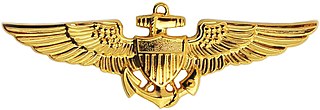
The Coast Guard Flight Officer Badge is a military badge of the United States Coast Guard that was issued until approximately 1988.

Military badges of the United States are awards authorized by the United States Armed Forces that signify rating, qualification, or accomplishment in several career fields, and also serve as identification devices for personnel occupying certain assignments. Personal recognition is granted to service members by a number of awards and decorations. Together with military decorations, such badges are authorized for wear on military uniforms.

The United States Coast Guard (USCG) is the coastal defense and maritime law enforcement branch of the United States Armed Forces and one of the country's seven uniformed services. The Coast Guard is a maritime, military, multi-mission service unique among the U.S. military branches for having a maritime law enforcement mission and a federal regulatory agency mission as part of its mission set. It operates under the U.S. Department of Homeland Security during peacetime, and can be transferred to the U.S. Department of the Navy by the U.S. President at any time, or by the U.S. Congress during times of war. This has happened twice: in 1917, during World War I, and in 1941, during World War II.
A Naval Aviation Observer insignia for Coast Guard personnel was first created in 1920 as a means of recognizing Coast Guard co-pilots and aircraft in-flight support personnel. The badge was the equivalent of the Naval Aviation Observer insignia for USN and USMC personnel. During the Second World War, issuance of the Coast Guard Aviation Observer insignia reached its peak, and the decoration was awarded throughout the Korean War. In the late 1960s, the Coast Guard Aviation Observer insignia began to be phased out due to a change in the structure of aviation training and the elimination of the title of Coast Guard Aviation Observers from approved aviation billets.
The Observer Badge is a military badge of the United States armed forces dating from the First World War. The badge was issued to co-pilots, navigators, and flight support personnel who had received a variation in the training required for the standard Pilot's Badge. The Observer Badge survived through the Second World War and into the 1950s, at which time the concept of an Observer Badge was phased out in favor of the modern Aircrew Badge and Navigator-Observer Badges. In addition to wings for Naval Aviators and Naval Flight Officers, the United States Navy still maintains an "Observer Badge" which is issued to flight-qualified mission specialists, such as a select number of meteorologists and intelligence officers in both the U.S. Navy and U.S. Marine Corps. The U.S. Air Force awards its USAF Observer Badge, which is identical to the USAF Navigator Badge, to Air Force officers who have qualified as NASA Space Shuttle Mission Specialists, have flown an actual mission aboard the shuttle and/or the International Space Station and who are otherwise not previously aeronautically rated as an Air Force pilot or navigator.

The Korean War was a war between North Korea and South Korea. The war began on 25 June 1950 when North Korea invaded South Korea following a series of clashes along the border.
In the mid-1980s, the Coast Guard Flight Officer insignia was briefly reinstated in the Coast Guard when the service took temporary custody of two E-2C Hawkeye aircraft from the U.S. Navy. This was part of an initiative to stand up a larger complement of Coast Guard E-2C aircraft, primarily in the counternarcotics and drug interdiction roles, augmented by Coast Guard HC-130s that would also be equipped with similar radar systems. The Coast Guard Flight Officer insignia is similar to the Naval Flight Officer insignia, minus the crossed sea anchors. The service recruited E-2C NFOs from the Navy, recommissioning them in the Coast Guard, as well as selecting a number of serving Coast Guard officers for NFO training.
A fatal Coast Guard E-2C aircraft mishap in the early 1990s spelled the end of the Coast Guard E-2C and enhanced HC-130 programs and the service transferred the remaining E-2C aircraft back to the Navy. [1]
The Coast Guard Flight Officer Badge became obsolete in 1991, although it is still authorized for wear on Coast Guard uniforms. [2]








